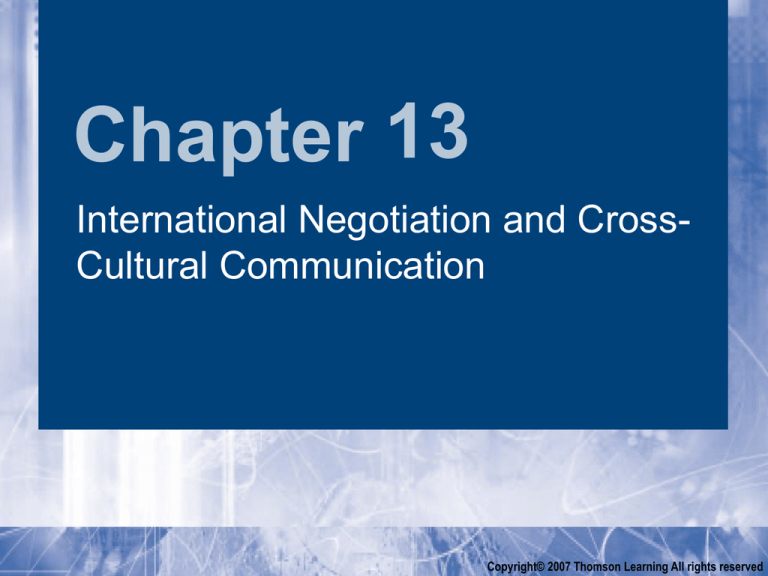
Chapter 13
International Negotiation and CrossCultural Communication
Copyright© 2007 Thomson Learning All rights reserved
Learning Objectives
• Understand the basics of verbal and nonverbal
communication
• Understand the basic international negotiation
processes
• Understand the basic tactics of international
negotiations
• Recognize and respond to the “dirty tricks”
Copyright© 2007 South-Western/Thomson Learning All rights reserved
Learning Objectives
• Know the difference between the problem-solving and
competitive approaches
• Identify the personal characteristics of the successful
international negotiator
Copyright© 2007 South-Western/Thomson Learning All rights reserved
International Negotiation
• Process of making business deals across cultures
• Precedes any multinational project
• Without successful negotiation and the accompanying
cross-cultural communication, there are seldom
successful business transactions
Copyright© 2007 South-Western/Thomson Learning All rights reserved
The Basic of Cross-Cultural
Communication
• Successful negotiation requires successful
communication
• Negotiators must understand all components of
culturally different communication styles (both verbal
and nonverbal)
Copyright© 2007 South-Western/Thomson Learning All rights reserved
Language and Culture
• Whorf hypothesis: theory that language determines the
nature of culture
• All languages have limited sets of words
• Words provide the concepts of understanding the world
• Restricted word sets constrain the ability to understand
the world
Copyright© 2007 South-Western/Thomson Learning All rights reserved
High- and Low-Context
Languages
• Low-context language: people state things directly and
explicitly
- Most northern European languages including
German, English, and the Scandinavian languages
• High-context language: people state things indirectly
and implicitly
- Asian and Arabic languages
Copyright© 2007 South-Western/Thomson Learning All rights reserved
Exhibit 13.1: Country Differences in
High-Context and Low-Context
Communication
Copyright© 2007 South-Western/Thomson Learning All rights reserved
Basic Communication Styles
• Direct communication: communication that comes to
the point and lacks ambiguity
• Formal communication: communication that
acknowledges rank, titles, and ceremony in prescribed
social interaction
Copyright© 2007 South-Western/Thomson Learning All rights reserved
Exhibit 13.2: Cultural Differences in
Communication Styles
Copyright© 2007 South-Western/Thomson Learning All rights reserved
Nonverbal Communication
• Communication without words
• Includes array of behaviors that enhance/supplement
spoken communication
• Include
- Kinesics, proxemics, haptics, oculesics, and olfactics
Copyright© 2007 South-Western/Thomson Learning All rights reserved
Kinesics
• Communication through body movements
- E.g., facial expressions, body posture
- Most Asian cultures use bowing to show respect
- No universal code for what body movements mean
- Easy to misinterpret gestures
Copyright© 2007 South-Western/Thomson Learning All rights reserved
Proxemics
• Use of space to communicate
- Each culture has appropriate distances for
communication
- The personal bubble of space may range from 9
inches to over 20 inches
- North Americans prefer more distance than Latin and
Arab cultures
Copyright© 2007 South-Western/Thomson Learning All rights reserved
Seating in a Typical Japanese Office
Copyright© 2007 South-Western/Thomson Learning All rights reserved
Haptics or Touching
• Communication through body contact
• Shaking hands, embracing, or kissing when greeting one
another
- No touching
• E.g., Japan, U.S., England, and many Northern
European countries
- Moderate touching
• E.g., Australia, China, Ireland, and India
- Touching
• E.g., Latin American countries, Italy, and Greece
Copyright© 2007 South-Western/Thomson Learning All rights reserved
Oculesics
• Communication through eye contact or gaze
- U.S. and Canada: people are very comfortable and
expect eye contact to be maintained
- China and Japan: eye contact is considered very
rude and disrespectful
Copyright© 2007 South-Western/Thomson Learning All rights reserved
Olfactics
• The use of smells as means of nonverbal
communication
- U.S. and U.K: find body odor offensive
- Arab: consider body odors natural
Copyright© 2007 South-Western/Thomson Learning All rights reserved
Practical Issues in CrossCultural Business
Communication
• Interpreter’s role: to provide a simultaneous translation
of a foreign language
- Require greater linguistic skills than speaking a
language or translating written documents
- Have the technical knowledge and vocabulary to
deal with technical details common in business
transactions
- Have to ensure the accuracy and common
understanding of agreements
Copyright© 2007 South-Western/Thomson Learning All rights reserved
Tips for Successful Use of
Interpreters
• Spend time with the interpreter
• Go over technical and other issues with interpreter for
proper understanding
• Insist on frequent interruptions when it’s necessary
• Look for feedback and comprehension by watching the
eyes
Copyright© 2007 South-Western/Thomson Learning All rights reserved
Tips for Successful use of
Interpreters (cont.)
• Discuss the message beforehand
• Request that your interpreter apologize for your
inability to speak in the local language
• Confirm that all key components of the message have
been properly comprehended
Copyright© 2007 South-Western/Thomson Learning All rights reserved
Communication with
Nonnative Speakers
• Use the most common words with most common
meanings
• Select words with few alternative meanings
• Follow rules of grammar strictly
• Speak with clear breaks between words
• Avoid sports words or words borrowed from literature
Copyright© 2007 South-Western/Thomson Learning All rights reserved
Communication with
Nonnative Speakers (cont.)
• Avoid words or expressions that are pictures
• Avoid slang
• Mimic the cultural flavor of the nonnative speaker’s
language
• summarize
• Test your communication success
• Repeat basic ideas using different words when your
counterpart does not understand
• Confirm important aspects in writing
Copyright© 2007 South-Western/Thomson Learning All rights reserved
Avoiding Attribution Errors
• Attribution: process by which we interpret the meaning
of spoken words or nonverbal exchanges
- Attribute meaning based on our taken-for-granted
cultural expectations
- Easy to make mistakes of attribution
- Need to observe carefully
- Avoid subtleties of a foreign language
- Avoid complex nonverbal behaviors
Copyright© 2007 South-Western/Thomson Learning All rights reserved
International Negotiation
• More complex than domestic negotiations
• Differences in national cultures and differences in
political, legal, and economic systems
• Steps in international negotiation
- Preparation, building the relationship, exchanging
information, first offer, persuasion, concessions,
agreement, and post agreement
Copyright© 2007 South-Western/Thomson Learning All rights reserved
Exhibit 13.3: Steps in International
Negotiations
Copyright© 2007 South-Western/Thomson Learning All rights reserved
Step 1: Preparation
•
•
•
•
•
•
•
•
•
Determine if the negotiation is possible
Know what your company wants
Be aware of what can be compromised
Know the other side
Send the proper team
What is the agenda?
Prepare for long negotiation
What is the environment like?
Plan a strategy
Copyright© 2007 South-Western/Thomson Learning All rights reserved
Cultural Differences in Key
Negotiating Processes
• Negotiation goal—signing the contract or forming a
relationship
• Formal or informal personal communication style
• Direct or indirect communication style
• Sensitivity to time—low or high
• Forms of agreement—specific or general
• Team organization—a team or one leader
Copyright© 2007 South-Western/Thomson Learning All rights reserved
Cultural Differences in Key
Negotiating Processes
• Attitude towards negotiation – win-lose or win-win
• High or low emotions
• Latin Americans and the Spanish: show their
emotions through negotiations
• Japanese and Germans: tend to be more reserved
Copyright© 2007 South-Western/Thomson Learning All rights reserved
Exhibit 13.4: Cultural Differences
in Preference for Broad
Agreements
Copyright© 2007 South-Western/Thomson Learning All rights reserved
Exhibit 13.5: Understanding
Negotiators from Other Countries
Copyright© 2007 South-Western/Thomson Learning All rights reserved
Step 2: Building the
Relationship
• First stage of the actual negotiation process
- No focus on business
- Partners get to know each other
- Social and interpersonal exchange
- Duration and importance vary by culture
Copyright© 2007 South-Western/Thomson Learning All rights reserved
Step 3: Exchanging
Information and the First Offer
• Both parties exchange information on their needs for
the agreement
• Parties exchange task-related information and first
offer
- Task-related information: actual details or the
proposed agreement
- First offer: first proposal by parties of what they
expect from the agreement
Copyright© 2007 South-Western/Thomson Learning All rights reserved
Exhibit 13.6: Information Exchange and
First-Offer Strategies
Copyright© 2007 South-Western/Thomson Learning All rights reserved
Step 4: Persuasion
• Stage when each side in the negotiation attempts to
get the other side to agree to its position
- Heart of the negotiation process
- Numerous tactics used
Copyright© 2007 South-Western/Thomson Learning All rights reserved
Verbal Negotiation Tactics
•
•
•
•
•
•
Promise
Threat
Recommendation
Warning
Reward
Punishment
Copyright© 2007 South-Western/Thomson Learning All rights reserved
Verbal Negotiation Tactics
•
•
•
•
•
•
Normative appeal
Commitment
Question
Command
Refusal
Interruption
Copyright© 2007 South-Western/Thomson Learning All rights reserved
Exhibit 13.7: Comparison of Brazilian,
U.S., and Japanese Negotiators (in
half-hour bargaining session)
Copyright© 2007 South-Western/Thomson Learning All rights reserved
Nonverbal Communication
• Body posture, facial expression, hand gestures, and
the use of personal space are a natural part of any
international negotiation
Copyright© 2007 South-Western/Thomson Learning All rights reserved
Dirty Tricks
• Negotiation tactics that pressure opponents to accept
unfair or undesirable agreements or concessions
Copyright© 2007 South-Western/Thomson Learning All rights reserved
Ploys/Dirty Tricks and
Responses
• Deliberate deception or bluffing—point out what you
believe is happening
• Stalling—do not reveal when you plan to leave
• Escalating authority—clarify decision making authority
• Good-guy, bad-guy routine—do not make any
concessions
Copyright© 2007 South-Western/Thomson Learning All rights reserved
Ploys/Dirty tricks and
Responses
• You are wealthy and we are poor—ignore the ploy
• Old friends—keep a psychological distance
Copyright© 2007 South-Western/Thomson Learning All rights reserved
Step 5 and 6: Concession and
Agreement
• Final agreement: signed contract, agreeable to all
sides
• Concession making: requires that each side relax
some of its demands
Copyright© 2007 South-Western/Thomson Learning All rights reserved
Styles of Concession
• Sequential approach: each side reciprocates
concessions
• Holistic approach: each side makes very few
concessions until the end of the negotiation
Copyright© 2007 South-Western/Thomson Learning All rights reserved
Basic Negotiation Strategies
• Competitive negotiation: each side tried to give as little
as possible and tries to “win” for its side
- The negotiation as a win-lose game
• Problem solving: negotiators seek out ground that is
beneficial to both companies’ interests
- Search for possible win-win situations
Copyright© 2007 South-Western/Thomson Learning All rights reserved
Exhibit 13.8: Competitive and ProblemSolving Negotiation in the Negotiating
Steps
Copyright© 2007 South-Western/Thomson Learning All rights reserved
Exhibit 13.9: Cultural Differences in
Preference for a Problem-Solving
Negotiation Strategy
Copyright© 2007 South-Western/Thomson Learning All rights reserved
Step 7: Post Agreement
• Commonly ignored step
• Consists of an evaluation of the success of a competed
negotiation
• Allows the garnering of insights from understanding
strengths and weaknesses of negotiation
Copyright© 2007 South-Western/Thomson Learning All rights reserved
The Successful International
Negotiator: Personal
Characteristics
•
•
•
•
•
•
•
Tolerance of ambiguity
Flexibility and creativity
Humor
Stamina
Empathy
Curiosity
Bilingualism
Copyright© 2007 South-Western/Thomson Learning All rights reserved
Major Points Regarding
Successful International
Negotiation
• Few negotiations succeed without extensive
preparation.
• Building personal relationships is a key step in a
negotiation.
• Managers should be aware that first offers may differ
by cultural background.
Copyright© 2007 South-Western/Thomson Learning All rights reserved
Major Points Regarding
Successful International
Negotiation
• Many tactics are used in persuasion.
• Know how counterpart views the concession-making
process.
• Culture and legal traditions influence the content and
force of law regarding business contracts.
• Competitive negotiation seldom leads to long-term
relationships.
Copyright© 2007 South-Western/Thomson Learning All rights reserved
Major Points Regarding
Successful International
Negotiation
• Problem-solving negotiation is more flexible and
probably more successful strategy.
• Must be flexible, empathic, and physically tough.
Copyright© 2007 South-Western/Thomson Learning All rights reserved
Conclusion
• Chapter examined the negotiating process and other
elements of cross-cultural communication
• International negotiations involves several steps
including: preparation, building the relationship,
persuasion, making concessions and reaching
agreement
• Successful negotiators prepare and understand these
steps well
Copyright© 2007 South-Western/Thomson Learning All rights reserved







